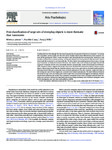Free classification of large sets of everyday objects is more thematic than taxonomic
| dc.contributor.author | Lawson, R | |
| dc.contributor.author | Chang, F | |
| dc.contributor.author | Wills, AJ | |
| dc.date.accessioned | 2016-11-17T13:23:36Z | |
| dc.date.available | 2016-11-17T13:23:36Z | |
| dc.date.issued | 2017-01-01 | |
| dc.identifier.issn | 0001-6918 | |
| dc.identifier.issn | 1873-6297 | |
| dc.identifier.uri | http://hdl.handle.net/10026.1/6756 | |
| dc.description.abstract |
Traditionally it has been thought that the overall organisation of categories in the brain is taxonomic. To examine this assumption, we had adults sort 140-150 diverse, familiar objects from different basic-level categories. Almost all the participants (80/81) sorted the objects more thematically than taxonomically. Sorting was only weakly modulated by taxonomic priming, and people still produced many thematically structured clusters when explicitly instructed to sort taxonomically. The first clusters that people produced were rated as having equal taxonomic and thematic structure. However, later clusters were rated as being increasingly thematically organised. A minority of items were consistently clustered taxonomically, but the overall dominance of thematically structured clusters suggests that people know more thematic than taxonomic relations among everyday objects. A final study showed that the semantic relations used to sort a given item in the initial studies predicted the proportion of thematic to taxonomic word associates generated to that item. However, unlike the results of the sorting task, most of these single word associates were related taxonomically. This latter difference between the results of large-scale, free sorting tasks versus single word association tasks suggests that thematic relations may be more numerous, but weaker, than taxonomic associations in our stored conceptual network. Novel statistical and numerical methods for objectively measuring sorting consistency were developed during the course of this investigation, and have been made publicly available. | |
| dc.format.extent | 26-40 | |
| dc.format.medium | Print-Electronic | |
| dc.language | en | |
| dc.language.iso | en | |
| dc.publisher | Elsevier BV | |
| dc.subject | Semantic knowledge | |
| dc.subject | Unsupervised categorization | |
| dc.subject | Free-sorting | |
| dc.subject | Concept | |
| dc.title | Free classification of large sets of everyday objects is more thematic than taxonomic | |
| dc.type | journal-article | |
| dc.type | Article | |
| plymouth.author-url | https://www.ncbi.nlm.nih.gov/pubmed/27863296 | |
| plymouth.volume | 172 | |
| plymouth.publication-status | Published | |
| plymouth.journal | Acta Psychologica | |
| dc.identifier.doi | 10.1016/j.actpsy.2016.11.001 | |
| plymouth.organisational-group | /Plymouth | |
| plymouth.organisational-group | /Plymouth/Admin Group - REF | |
| plymouth.organisational-group | /Plymouth/Admin Group - REF/REF Admin Group - FoH | |
| plymouth.organisational-group | /Plymouth/Faculty of Health | |
| plymouth.organisational-group | /Plymouth/Faculty of Health/School of Psychology | |
| plymouth.organisational-group | /Plymouth/REF 2021 Researchers by UoA | |
| plymouth.organisational-group | /Plymouth/REF 2021 Researchers by UoA/UoA04 Psychology, Psychiatry and Neuroscience | |
| plymouth.organisational-group | /Plymouth/Research Groups | |
| plymouth.organisational-group | /Plymouth/Research Groups/Institute of Health and Community | |
| plymouth.organisational-group | /Plymouth/Users by role | |
| plymouth.organisational-group | /Plymouth/Users by role/Academics | |
| dc.publisher.place | Netherlands | |
| dcterms.dateAccepted | 2016-11-01 | |
| dc.identifier.eissn | 1873-6297 | |
| dc.rights.embargoperiod | No embargo | |
| rioxxterms.versionofrecord | 10.1016/j.actpsy.2016.11.001 | |
| rioxxterms.licenseref.uri | http://www.rioxx.net/licenses/all-rights-reserved | |
| rioxxterms.licenseref.startdate | 2017-01-01 | |
| rioxxterms.type | Journal Article/Review | |
| plymouth.oa-location | http://www.sciencedirect.com/science/article/pii/S0001691816303080?via=ihub |


